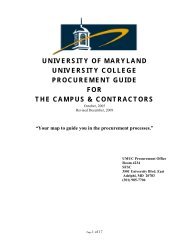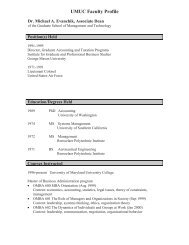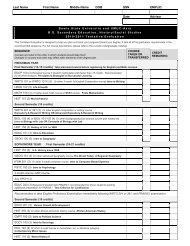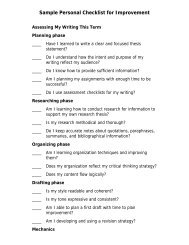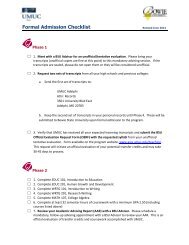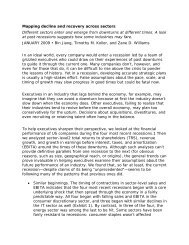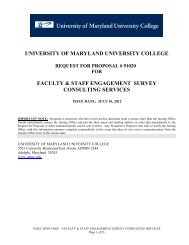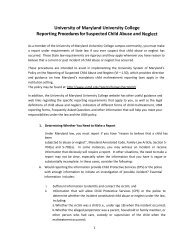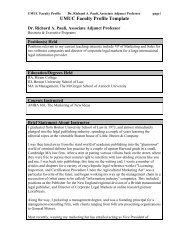1a. IntroSUS 2003 - University of Maryland University College
1a. IntroSUS 2003 - University of Maryland University College
1a. IntroSUS 2003 - University of Maryland University College
- No tags were found...
Create successful ePaper yourself
Turn your PDF publications into a flip-book with our unique Google optimized e-Paper software.
EnvironmentalManagementCourses in environmental management (designated ENMT) maybe applied as appropriate (according to individual programrequirements) toward• a major or minor in environmental management or managementstudies;• a certificate in Bio-Security or Environmental Management;and• electives.Courses in environmental management require a basic scientificfoundation. Before enrolling, students are recommended to completethe related requirements in math and science and shouldconsult an advisor.A description <strong>of</strong> the curriculum for the environmental managementmajor and minor begins on p. 56. A description <strong>of</strong> the curriculumfor the management studies major and minor begins on p. 72.ENMT 301 Environment and EcosystemsManagement (3)(Fulfills the civic responsibility requirement.) An overview <strong>of</strong> thescientific principles governing ecosystems, particularly as theyrelate to the environmental consequences <strong>of</strong> resource developmentand industrial processes. Topics are drawn from the fields <strong>of</strong> geology,hydrology, meteorology, and ecology. The historical development<strong>of</strong> environmental management issues and approaches isintroduced. Principles <strong>of</strong> environmental management at the local,regional, and global levels are also covered.ENMT 305 Hazardous MaterialsToxicology (3)An introduction to regulatory issues with a focus on the physicaland chemical characteristics <strong>of</strong> nuclear, hazardous chemical, andmixed-waste materials. The normal function <strong>of</strong> human body systemsis studied, drawing on the fields <strong>of</strong> chemistry, biochemistry, anatomy,and physiology. Basic principles <strong>of</strong> toxicology are applied to providean overview <strong>of</strong> human health effects associated with exposure tohazardous chemicals in the community and in work environments.ENMT 310 Emergency Planning andOperations Management (3)A review <strong>of</strong> human-made and natural hazards and emergencypreparednesslaws. The relationships between industrial processesand hazardous materials are covered. Focus is on developing skillsto work safely in a hazardous environment and to prepare hazardousmaterials for transportation, processing, and disposal.Topics include elements <strong>of</strong> hazardous materials emergency planning,such as direction and control <strong>of</strong> emergency response andremediation. Preparation <strong>of</strong> emergency plans, methodology <strong>of</strong> disasterresponse, and performance <strong>of</strong> emergency operations are alsoreviewed. Practical exercises demonstrate how to prepare for andrespond to emergencies.ENMT 315 Environmental Audits andPermits (3)A study <strong>of</strong> the principles <strong>of</strong> environmental impact assessment andan in-depth look at various laws, regulations, and methods <strong>of</strong> performingdue diligence audits. Topics include the regulatoryrequirements <strong>of</strong> NEPA, EIS reports, types <strong>of</strong> audits, ISO 14000environmental systems standards, ASTM audit procedures,Department <strong>of</strong> Health and Safety audits, common law privileges,and self-regulation and business transfer statutes. Strategies andmethodology for obtaining environmental permits and complianceare also reviewed.ENMT 320 Environmental and OccupationalHealth and Safety Management (3)A study <strong>of</strong> the principles <strong>of</strong> health and safety management. Topicsinclude recognition, evaluation, and control <strong>of</strong> hazards; medicalsurveillance; personal protective equipment; spill and exposureprevention; and contamination reduction and removal methods.Emphasis is on relating these principles to the regulatory processes(e.g., OSHA/NIOSH) governing environmental and occupationalhealth and safety.ENMT 325 The Biosphere, Energy, andSustainable Development (3)(Fulfills the civic responsibility requirement.) An overview <strong>of</strong>biodiversity, conservation, assessment methods, and mitigation.Topics include the relationship between energy and the environment,the impact <strong>of</strong> fossil fuels on the environment, global concerns<strong>of</strong> ozone depletion and climate change, alternative andrenewable energy sources, conservation and technical advances,and sustainable energy development. Global agreements to balanceeconomic growth against life-support systems and the naturalresource base are surveyed. The collective thinking <strong>of</strong> variousexperts—to advance and create sustainable development, definingthe new paradigm and its implications for economic growth andmanaging the environment—is also explored.166




